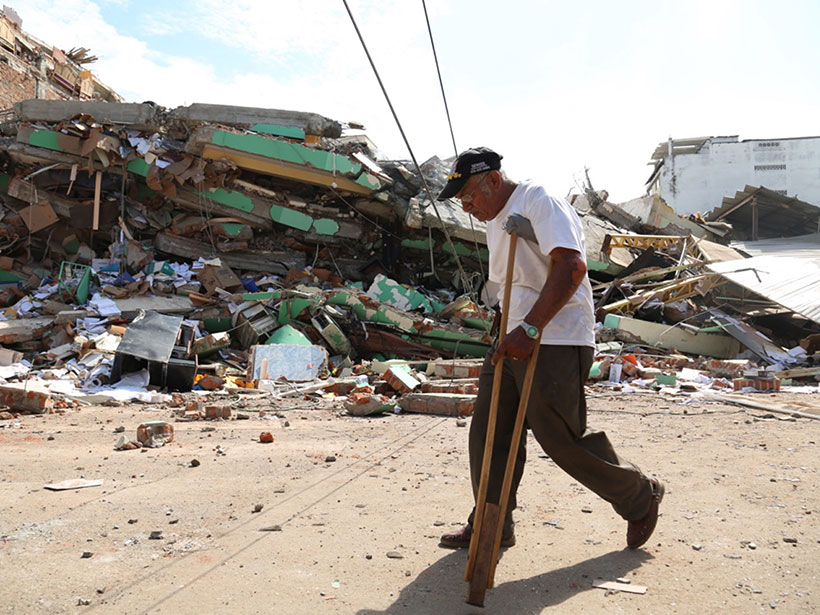A 7.8 magnitude earthquake struck Ecuador Saturday night, killing 276, injuring more than 2000 people, and flattening homes and businesses in the northwestern region of Manabi. The cities of Manta, Portoviejo, and Pedernales sustained the worst of the devastation, according to Ecuadoran President Rafael Correa, but even regions several hundred kilometers away recorded some damage. NPR reported that the hardest-hit areas are remote and impoverished. The earthquake was felt as far away as Peru and Colombia.
Although President Correa had embarked on a visit to Italy, he cut the trip short to return to Ecuador, where he declared a state of emergency. The nation mobilized its national police and armed forces as part of its emergency response.
Ecuador’s Tectonics
The megathrust earthquake resulted from sudden movement along a subduction zone along the west coast of South and Central America, according to the U.S. Geological Survey (USGS). There, the Nazca plate slides under the South America plate at rate of 61–80 millimeters per year. USGS identified the earthquake’s epicenter as shallow, around 19.2 kilometers deep.
Since 1900, Ecuador has endured seven earthquakes of magnitude 7 or higher.
Ecuador has sustained large earthquakes like this before—the country sits on the Pacific’s 40,000-kilometer-long Ring of Fire around the edges of the Pacific basin, where many of the Earth’s tectonic plates converge. Since 1900, Ecuador has endured seven earthquakes of magnitude 7 or higher. The last one occurred in March of 1987, 240 kilometers east of Saturday’s quake.
Ecuador’s latest earthquake took place on 16 April at approximately 8 p.m. Eastern U.S. time just after several earthquakes in southwest Japan. A pair of temblors of magnitudes 6.0 and 6.2 rumbled through the Japanese region on 14 April, killing nine and injuring hundreds. The next day a 7.0 magnitude earthquake jolted the island of Kyushu. However, a physical link between the two countries’ events is unlikely, Phil Cummins, a seismologist and mathematical geophysicist at the Australian National University in Canberra, told New Scientist.
Possible Foreshocks
A man who was in Ecuador’s capital, Quito, when Saturday’s earthquake hit told BBC News that he had felt “small tremors going on for about 2 or 3 months, and I thought it was one of those but after about 20, 30 seconds it started to get really strong.”
Roland Burgmann, a seismologist at the University of California, Berkeley, told Eos in an email that “quite a few large earthquakes are preceded by smaller foreshocks, most notably the 2011 M9 Tohoku earthquake. So it’s possible that the Ecuador [earthquake] was preceded by smaller events.”
However, “the problem is that we haven’t figured out a way yet that allows us to recognize small events as foreshocks,” he said.
Japan Quake Prompted Evacuation
In Japan, authorities evacuated 44,000 people from the town of Mashiki after the initial earthquake on Thursday, according to the Guardian.
The string of earthquakes that struck Japan in the past few days resulted from movements at shallow depth along a strike-slip fault several hundred kilometers northwest of the Ryukyu Trench, where the Philippine Sea plate subducts beneath the Eurasia plate, USGS reported.
Most earthquakes in the affected region of Japan arise from shifting of tectonic plates along the subduction zone, USGS noted. The agency reports that only 13 events of magnitude 5 or higher have occurred at depths above 50 kilometers in this region during the last century.
—JoAnna Wendel, Staff Writer
Citation: Wendel, J. (2016), Ecuador earthquake kills hundreds, injures thousands, Eos, 97, doi:10.1029/2016EO050671. Published on 18 April 2016.
Text © 2016. The authors. CC BY-NC-ND 3.0
Except where otherwise noted, images are subject to copyright. Any reuse without express permission from the copyright owner is prohibited.

